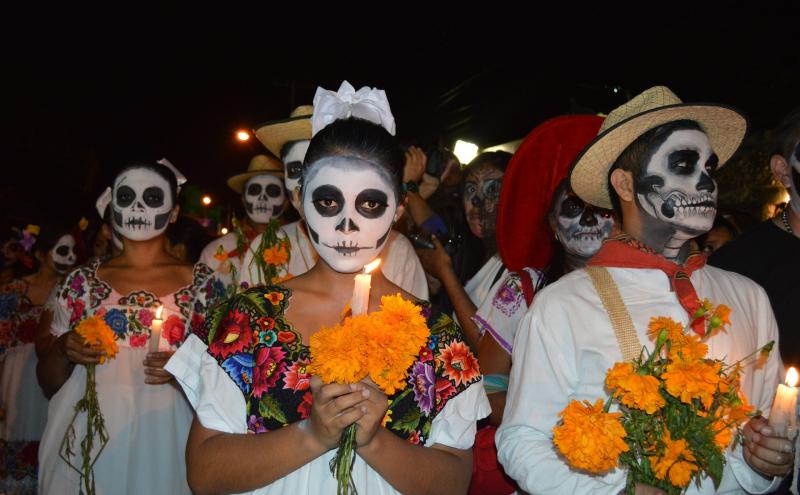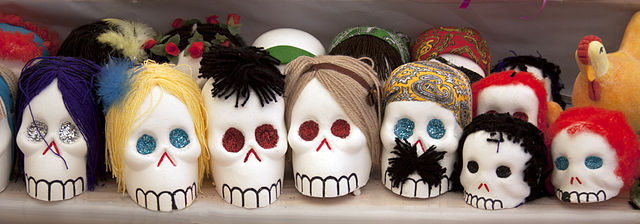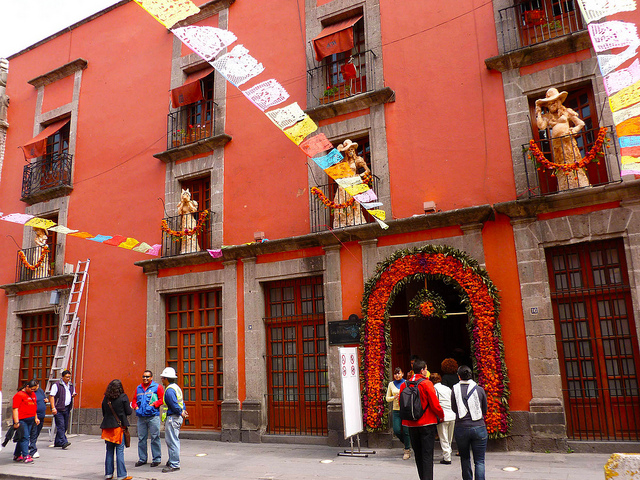
The Puget Sound region has a rich heritage, a diverse community, and convenient connections to global cultures through Seattle-Tacoma International Airport (SEA).
Latin American countries kick off November with Día de los Muertos, the Day of the Dead celebration.
Background
In Mexico and the Americas, the Day of the Dead honors and remembers loved ones who have passed on. Family members visit, clean, and decorate the grave sites of their deceased loved ones.
A central part of the celebration is an altar that is built in private homes or cemeteries. They’re a place for families to gather and remember relatives and welcome their spirits back for a brief visit during the two-day celebration. The intent is to encourage visits by the souls, so the souls will hear the prayers and the comments of the living directed to them. Celebrations can take a humorous tone, as celebrants remember funny events and anecdotes about the departed.
Families bring offerings like:
- Water to quench a spirit’s thirst after a long journey
- Family photos
- A candle to honor each relative
- Small toys for younger relatives who passed on
- Food, like relatives’ favorite food and drink
- Marigolds for decoration and to guide relatives back
- Incense to carry praise to relatives
Food
Delicious food is a big part of this holiday. Here are a few treats you could eat at celebrations:
- Tamales
- Tres leches cake (three milks cake), a sponge cake soaked in three kinds of milk: evaporated, condensed, and heavy cream
- Pan de muerto, a sweet egg bread decorated with bones and skulls made from white icing
- Candied pumpkin
- Hibiscus iced tea or jamaica
- Pulque, a fermented alcoholic beverage made from agave sap that has the color of milk and a sour taste
- Atole, a delicious porridge made from corn flour, and spiced with sugar, cinnamon, and vanilla
Skulls and Skeletons
The Calavera Catrina, a beautiful and well-dressed skeleton, is the most visible and beloved symbol of the holiday. People spill into the streets with their faces painted as skeletons, wearing fancy dress, and donning clanking shells or other noisemakers. Costumes and rambunctious public gatherings are the biggest part of the fun, and people celebrate with music and parades.

In the early 1900s, Mexican political cartoonist and lithographer José Guadalupe Posada said “Todos somos Calaveras.” Or “We are all skeletons,” meaning that deep down inside under our external appearances, we are all the same and we all end up in the same place. Sugar skulls are one of the most well-known and beautiful traditions, with bright colors and glittering metallic decorations. They’re given as gifts to the living and offered at altars to relatives who have passed.
Decorations

Vibrant decorations and brilliant color light up the festivities. Common decorations include yellow marigolds, brightly colored tissue paper decorations, beautiful candy skulls, and dancing in colorful costumes. The bright color of the flowers and their strong scent is believed to help guide the dead from the cemeteries back to their homes for a visit. Pillows and blankets are left out for the returning relatives so they can rest after their long journey back home.
Papel picado, brightly colored strings of tissue paper, adorn the streets and signify the wind and the fragility of life. Butterflies also symbolize the holiday because of their ability to travel home from long distances.
Five Fun Facts:
1. It’s not the Mexican version of Halloween
The concept of Halloween focuses on dark and spooky; Day of the Dead is a celebration of life, not death, and is life-affirming, humorous, rambunctious, and colorful
2. It’s a cultural treasure
In 2008, UNESCO put the holiday on its list of Intangible Cultural Heritage of Humanity
3. It’s timed around corn
The date of the festival began to celebrate the annual maize (corn) harvest for the Aztec, Toltec, and other Nahuatl people
4. It’s poetic
The holiday features calaveras literarias or calaveritas, short and humorous poems that poke fun at the living and pay tribute to the dead. These poems can also satirize political figures or famous people in a way that suggests they’re dead, even if they’re not.
5. It’s influencing popular culture
Day of the Dead folk art was the inspiration for several movies, including Pixar's "Coco," Tim Burton’s “Nightmare Before Christmas” and “Corpse Bride.” It also appeared in Spectre, the 2015 James Bond movie with Daniel Craig.







